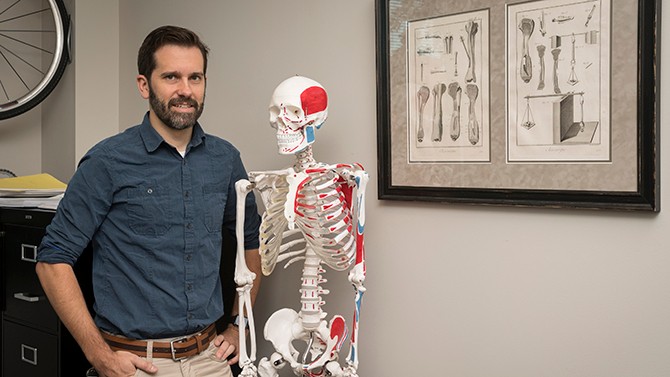NSF grant supports research to shed light on how cartilage works
Cartilage, a connective tissue found throughout the body, is critical to the function of our joints. Tough yet flexible, it supports load and enables frictionless motion between joint surfaces.
“Cartilage performs these functions remarkably well…until it doesn’t,” says Christopher Price, assistant professor of biomedical engineering at the University of Delaware.
Popular thinking has been that cartilage degrades as we use it, much like bearings in an engine wearing down over time, but recent research has shown that activities like walking and running actually decrease the risk of joint failure.
“During loading, interstitial fluid, which comprises about 80 percent of cartilage, is automatically pressurized to support load and lubricate the joint,” Price says.
“But pressurization also leads to fluid exuding, or oozing out, from the tissue. Thus, inactivity is likely a risk factor for joint disease because it defeats the biological, mechanical, and friction-related, or tribological, functions of cartilage. Static loading of a joint by standing or sitting for just 30 minutes causes joint spaces to thin considerably, a detrimental process that reverses itself during movement.”
But the fact that activity prevents the otherwise inevitable collapse of cartilage does little to explain the underlying mechanism of cartilage recovery.
Now, with support from a National Science Foundation grant, Price is partnering with mechanical engineering professor David Burris to provide evidence of an alternative recovery mechanism and to fill some of the gaps in understanding of joint mechanics.
The work will also shed light on tribology, Burris’s area of expertise, as well as cartilage nutrient transport and mechanobiology, a term that refers to the ways in which changes in cell or tissue mechanics contribute to development, physiology, and disease.
The researchers believe that joint function is best explained by unifying two prevalent lubrication theories — one focusing on internal, and the other on external, pressure and flow fields.
“Our experiments suggest that these two theories, interstitial lubrication and hydrodynamics, are actually interconnected,” Price says.
In short, based on previous findings, they have evidence that the joint functions like a self-pressurizing hydrostatic bearing.
“The matrix of the tissue effectively acts as a reservoir of pressurized fluid and can maintain reasonable interstitial pressures and lubrication over hours of inactivity in a typical joint — but it can’t do this indefinitely,” Price explains.
“Eventually, activity is required to replace the fluid lost to compression-induced fluid exudation,” he continues. “At that point, sliding action hydrodynamically forces fluid from the joint space through the porous surface of articular cartilage and into the tissue, thereby restoring mechanical stiffness and lubricity, while preparing the tissue for the next round of inactivity.”
The researchers will use a combination of mathematical modeling, mechanical testing, and bio-imaging in the study. Their hope is that the work will lead to new insights into joint mechanics, disease development, and the design of new bio-inspired joint replacement systems.
Of most immediate interest to the public is the possibility that, in addition to weight control and overall health, physical activity may represent a prescription for promoting joint health.
“If it turns out that we’re right, maybe people will stop telling runners that they’re ruining their knees,” Price says.


